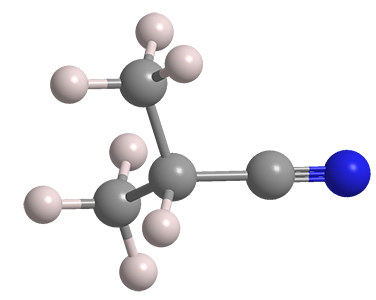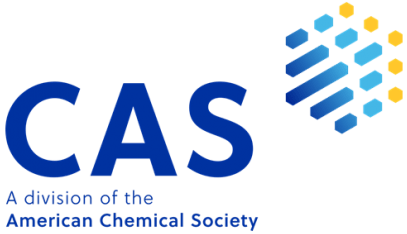What molecule am I?


Isobutyronitrile, often called isopropyl cyanide, is a highly toxic liquid with the aroma of almonds. An early synthesis of the compound from isobutyl alcohol and ammonia was reported by Tohoru Hara and Shigeru Komatsu at Kyoto Imperial University in 1925. Today, isobutyronitrile is generally made by passing isobutyl alcohol or isobutyraldehyde and ammonia over a suitable catalyst at high temperatures.
Isobutyronitrile has only a few uses. It is an industrial solvent and a starting material for producing insecticides such as diazinon. Recently, several patents mention isobutyronitrile as a cosolvent in battery electrolytes.
Despite its relative obscurity, isobutyronitrile made big news in 2014, when astronomers detected it in the interstellar medium. Hundreds of other molecules have been found in space, but isobutyronitrile was unique in that its carbon chain is branched, as opposed to linear. Using the then-new Atacama Large Millimeter/submillimeter Array telescope in Chile, Arnaud Belloche and colleagues at the Max Planck Institute for Radio Astronomy (Bonn, Germany) found the molecule in a massive star-forming region called Sagittarius B2.
This finding was especially significant because it may be a clue that branched-chain amino acids are also present in star-forming regions.
Isobutyronitrile hazard information*
| Hazard class** | Hazard statement | |
|---|---|---|
| Flammable liquids, category 2 | H225—Highly flammable liquid and vapor | |
| Acute toxicity, oral, category 2 | H300—Fatal if swallowed | |
| Acute toxicity, dermal, category 3 | H311—Toxic in contact with skin | |
| Skin corrosion/irritation, category 2 | H315—Causes skin irritation | |
| Serious eye damage/eye irritation, category 2A | H319—Causes serious eye irritation | |
| Acute toxicity, inhalation, category 3 | H331—Toxic if inhaled | |
| Specific target organ toxicity, single exposure, respiratory tract irritation, category 3 | H335—May cause respiratory irritation | |
| Specific target organ toxicity, single exposure, liver, category 2 | H371—May cause damage to liver | |
*Compilation of multiple safety data sheets.
**Globally Harmonized System of Classification and Labeling of Chemicals.
Explanation of pictograms.
Last month, Pfizer announced that the first orally administered drug to inhibit the COVID-19 virus had entered Phase 1 clinical trials. The molecule, with the experimental designation PF-07321332, targets the virus’ main protease. If PF-07321332 proves to be safe and effective, it will have the advantage over injectables because it can be given outside of hospitals and clinics.
Molecule of the Future
Once a month we bring you a newly discovered or developed molecule that has important implications for the future of chemistry or society in general. Look for it the third week of each month. Learn more about this month's Molecule of the Future below.
We're looking for more molecules of the future!
Do you have a suggestion for the next molecule of the future? Send your idea to MOTW.
This molecule was suggested by a reader. We present almost all of the molecules suggested by our readers. If you have a molecule you would like us to consider, please send us a message. And thank you for your interest in Molecule of the Week! —Ed.
Isobutyronitrile fast facts
| CAS Reg. No. | 78-82-0 |
| SciFinder nomenclature | Propanenitrile, 2-methyl- |
| Empirical formula | C4H7N |
| Molar mass | 69.11 g/mol |
| Appearance | Colorless liquid |
| Boiling point | 103.9 ºC |
| Water solubility | ≈3 g/L (est) |
MOTW update
Trichloroisocyanuric acid, commonly known as “trichlor” or “pool chlorine”, was the Molecule of the Week for March 2, 2009. It is widely used in tablet form to eradicate microorganisms in swimming pools and hot tubs. This year, pool owners may have to look for alternative chlorinating agents because trichlor is in limited supply. The shortage is the result of a fire last year at the BioLab plant in Westlake, LA. The fire was touched off when Hurricane Laura struck the plant.

Learn more about this molecule from CAS, the most authoritative and comprehensive source for chemical information.
Molecule of the Week needs your suggestions!
If your favorite molecule is not in our archive, please send us a message. The molecule can be notable for its current or historical importance or for any quirky reason. Thank you!
Stay Ahead of the Chemistry Curve
Learn how ACS can help you stay ahead in the world of chemistry.


